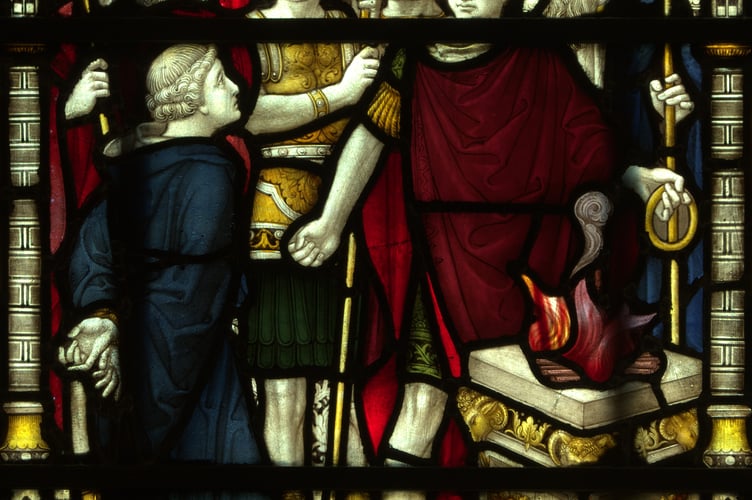WE are more used to looking through windows than reading them like a book, writes Judith Field.
But stained-glass windows are more than just a pretty picture, and when we visit cathedrals this summer, knowing what to look out for can make our sightseeing much more interesting.
Stained-glass windows perform three essential jobs: they let light in, keep draughts out … and tell stories, especially at Truro Cathedral (built 1880-1910).
More than 30 of its dazzling array of windows consist of a ‘speaking group.’ In each, a significant historical figure stands above a scene from their life, with two related characters seated at their feet.
By reading these windows, you can explore some of the biggest turning points in European history and get an insight into their makers: the Victorians, at the height of the British Empire.
So how do you read a stained-glass window? As a general rule, symbols are used in stained glass to help identify individuals or themes. For instance, strawberries, lilies and carnations symbolise the Virgin Mary, and most people are familiar with the shorthand of doves for the Holy Spirit and halos for saints. Yet how many people are aware that a palm frond identifies a martyr?
Palm fronds are carried by all three characters in one of the Truro Cathedral windows: Pancras (of Rome), Catherine (of Alexandria) and Alban (of England). All were cruelly executed for their faith by the Romans. Why did that happen, and what was its impact?
In the second half of the third century AD, the Roman Empire was in trouble, its authority crumbling, invaders on all sides. It equated loyalty to the empire with loyalty to its state religion, and required all citizens to sacrifice animals to gods such as Mars and Neptune. When a minority of Christians refused, they were brutally put to death.
Alban is a good example. A Roman citizen living in Hertfordshire, he hid a priest being hunted down by the army, swapping places with him to help him get away. In a scene vividly portrayed in the window, Alban was arrested and tried before a judge who insisted that he make a sacrifice on a pagan altar. As a Christian, Alban refused. He was beheaded on the spot.

Persecution should have spelt the end of Christianity, but the bravery of the martyrs was inspirational and, unexpectedly, helped the faith to spread rapidly. By 312AD, even the Emperor Constantine converted, paving the way for Christianity to dominate European thought, culture and society for centuries.
And what of the martyrs? Their names live on whilst those who killed them are forgotten. St Albans and St Pancras International may be upcountry, but Cornwall has a 12th century St Catherine's Church, located in the tiny hamlet of Temple on Bodmin Moor; familiar items, like Bonfire Night’s Catherine wheels, have their origin in these events.
Truro Cathedral is a charity, and donations help preserve its unique story-telling heritage. Please consider giving when you visit.





Comments
This article has no comments yet. Be the first to leave a comment.